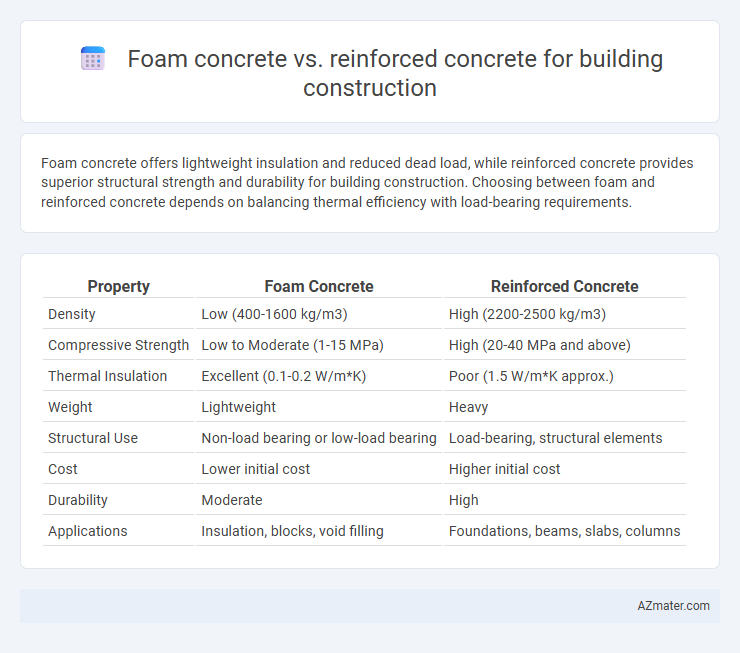Foam concrete offers lightweight insulation and reduced dead load, while reinforced concrete provides superior structural strength and durability for building construction. Choosing between foam and reinforced concrete depends on balancing thermal efficiency with load-bearing requirements.
Table of Comparison
| Property | Foam Concrete | Reinforced Concrete |
|---|---|---|
| Density | Low (400-1600 kg/m3) | High (2200-2500 kg/m3) |
| Compressive Strength | Low to Moderate (1-15 MPa) | High (20-40 MPa and above) |
| Thermal Insulation | Excellent (0.1-0.2 W/m*K) | Poor (1.5 W/m*K approx.) |
| Weight | Lightweight | Heavy |
| Structural Use | Non-load bearing or low-load bearing | Load-bearing, structural elements |
| Cost | Lower initial cost | Higher initial cost |
| Durability | Moderate | High |
| Applications | Insulation, blocks, void filling | Foundations, beams, slabs, columns |
Introduction to Foam Concrete and Reinforced Concrete
Foam concrete is a lightweight, cellular material produced by mixing cement slurry with stable foam, offering benefits such as excellent thermal insulation, fire resistance, and reduced structural load in building construction. Reinforced concrete combines concrete's compressive strength with steel reinforcement bars that provide tensile strength, making it a versatile and durable choice for load-bearing structures and buildings requiring high structural integrity. Both materials serve distinct purposes, with foam concrete preferred for insulation and lightweight fills, while reinforced concrete is essential for foundational and heavy-duty applications.
Composition and Material Differences
Foam concrete is composed of cement, water, and a foaming agent that creates air bubbles, resulting in a lightweight, porous material with lower density compared to reinforced concrete. Reinforced concrete combines cement, water, fine and coarse aggregates, and steel reinforcement bars, providing high compressive and tensile strength essential for structural support. The primary material difference lies in foam concrete's cellular structure, which offers thermal insulation and reduced weight, whereas reinforced concrete delivers superior load-bearing capacity and durability.
Structural Strength and Load-Bearing Capacity
Foam concrete offers lightweight properties with moderate compressive strength, making it suitable for non-load-bearing applications, whereas reinforced concrete provides superior structural strength and high load-bearing capacity essential for critical structural elements. Reinforced concrete's combination of concrete and steel reinforcement allows it to withstand tensile and compressive forces effectively, ensuring durability in high-stress environments. The load-bearing capacity of reinforced concrete significantly surpasses foam concrete, making it the preferred choice for foundations, beams, and columns in building construction.
Thermal and Acoustic Insulation Properties
Foam concrete offers superior thermal insulation due to its low density and high air content, reducing heat transfer and energy consumption in buildings. In contrast, reinforced concrete provides limited thermal insulation but excels in structural strength and load-bearing capacity. Acoustic insulation is enhanced in foam concrete because of its porous structure, which absorbs sound waves more effectively than the dense, solid matrix of reinforced concrete.
Durability and Lifespan Comparisons
Foam concrete offers superior thermal insulation and lightweight properties but generally has lower compressive strength and durability compared to reinforced concrete, making it less suitable for load-bearing structures with long lifespans. Reinforced concrete, enhanced with steel reinforcement, provides high durability, resistance to environmental stressors, and a typical lifespan exceeding 50 years in most building applications. Maintenance and exposure conditions significantly influence the longevity of both materials, but reinforced concrete remains the preferred choice for structural components demanding long-term durability.
Weight and Density Considerations
Foam concrete exhibits significantly lower density, typically ranging from 400 to 1600 kg/m3, compared to reinforced concrete, which usually weighs around 2400 kg/m3. This reduced weight makes foam concrete ideal for applications requiring lightweight materials to minimize structural load and improve thermal insulation. In contrast, reinforced concrete's higher density provides superior strength and durability, making it suitable for load-bearing structures despite its heavier mass.
Construction Speed and Ease of Installation
Foam concrete offers significantly faster construction speed due to its lightweight nature and ease of pouring in complex shapes without heavy machinery, reducing installation time compared to traditional reinforced concrete. Reinforced concrete requires extensive formwork, steel reinforcement placement, and curing time, which lengthens the construction process and demands skilled labor. The simplified handling and quicker setting properties of foam concrete enable streamlined workflows and faster project completion in building construction.
Cost Analysis and Economic Factors
Foam concrete offers significant cost savings in building construction due to its lightweight nature, reducing foundation and structural load expenses compared to reinforced concrete. Reinforced concrete, while more expensive due to steel and higher material density, provides superior strength and durability, often justifying its higher upfront costs in long-term infrastructure projects. Economically, foam concrete is advantageous for non-load-bearing elements and insulation purposes, whereas reinforced concrete remains essential for structural integrity in load-bearing applications.
Sustainability and Environmental Impact
Foam concrete offers significant sustainability advantages over reinforced concrete by utilizing lightweight materials and reducing cement usage, which lowers carbon dioxide emissions during production. Reinforced concrete, while structurally strong, has a higher environmental impact due to extensive cement consumption and embedded steel, leading to increased energy use and resource depletion. Incorporating foam concrete in building construction enhances thermal insulation and reduces overall environmental footprint, supporting eco-friendly and energy-efficient architectural projects.
Ideal Applications in Building Construction
Foam concrete excels in lightweight construction applications such as non-load-bearing walls, insulation layers, and soundproofing due to its low density and thermal insulation properties. Reinforced concrete is ideal for structural elements like beams, columns, and foundations where high compressive strength and load-bearing capacity are critical. Choosing between foam concrete and reinforced concrete depends on specific project requirements, including load demands, thermal performance, and cost-efficiency.

Infographic: Foam concrete vs Reinforced concrete for Building construction
 azmater.com
azmater.com